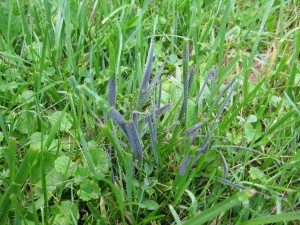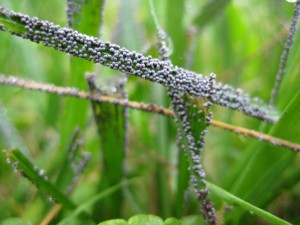Your turf has been slimed?
A common slime mold of turf may alarm property owners unnecessarily. Invasive Pest Solutions™ can help you identify property pests during monitoring and service visits, routine elements of our Integrated Habitat Management™ service plans.
The discolored powdery-looking patches in your turf may be nothing of consequence, just a temporary distraction lasting only a few days. Small patches (3″ to 10″) of powdery gray, purple-blue, white, orange, or yellow slime mold fruiting bodies appear overnight from April through October.
Slime mold is an odd organism, not a fungus at all. It’s out there all the time and it’s abundant, but infrequently seen. Common turf slime lives most of the time out of sight in the soil and thatch. Warm weather followed by rainfall causes the slime to rise up along blades of grass to form fruiting bodies, little sacks high on grass blades where the wind can dry them and open them, releasing countless tiny spores.
Fruiting bodies of slime molds in the genus Mucilago ssp. are mistaken by some operators for destructive molds called powdery mildews. There’s a spray for that. Turf slime rarely becomes a serious pest and chemical counter-measures are likely unnecessary. Nevertheless, the small patches of odd color may be unsightly and can be controlled simply and inexpensively. Just direct a water spray from the hose onto the patches and rinse the slime off the grass blades.

